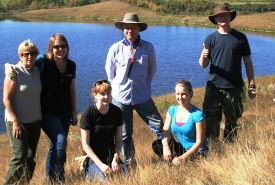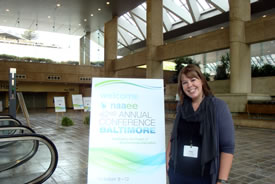Exploring new ways of connecting people with nature: Insights from the 2013 North American Association for Environmental Education conference

NCC staff and volunteers tackling invasive species at Collins Property, Red Deer River Natural Area, AB (Photo by NCC)
How can we expect someone to care about nature if they've had no personal experience with it? Endangered species, critical habitats, biodiversity — though we deal with these concepts every day at the Nature Conservancy of Canada (NCC), they are abstract, intangible and foreign to many.
In our fast-paced, urbanized world, exposure to nature is decreasing and people are less connected to their surroundings. As a result, we are far less likely to make informed, sustainable choices and understand the full extent of our impacts on the environment. But you know what they say! Knowledge is power, and a well-informed, engaged citizenry can be an unstoppable force for nature. It all comes back to giving people the opportunity to learn and connect with nature by experiencing it first-hand.
Through our Conservation Volunteers program we are continually looking for new ways to engage people in our work and provide meaningful, educational (and fun!) experiences in nature. In my three years as coordinator for the program in Alberta, I have witnessed the positive effects of education and engagement. When people experience things first-hand, they learn more and want to do more.

Kailey Setter at the NAAEE conference (Photo by NCC)
Keen to find new ways to connect our supporters and volunteers with nature, I travelled to Baltimore, Maryland this past October to attend the 42nd annual North American Association for Environmental Education conference. I wanted to hear others' success stories, and learn more about the innovative ways they were connecting the public with the environment through education and engagement.
The conference explored seven different environmental education themes, including:
- connecting kids with nature
- conservation education and behaviour change
- greening formal education
- leadership and innovation
- sustainable communities
- public participation in scientific research (also known as citizen science)
Use of technology as an engagement tool
This was a hot topic, especially the use of mobile apps. The California Academy of Sciences is currently using the popular iNaturalist app to engage people in documenting California’s biodiversity through photos. Not only is this initiative increasing environmental literacy among the public, it is also furthering biodiversity research.
Similarly, professional and amateur birders are using the iBird app to document their sightings and learn more about the various species they encounter. Both apps harness the power of community. They provide a platform where people can share knowledge and connect with other nature lovers around the world.
Check out this list of top 10 apps for taking technology outdoors, produced by the National Environmental Education Foundation.
Engaging urban, underserved communities in conservation
The Nature Conservancy (U.S.) provides paid four-week summer internships for high school students every year through its LEAF program (Leaders in Environmental Action for the Future). By targeting urban youth from populations that are less engaged in conservation, the program seeks to empower future conservation leaders in the areas where they are needed most.
The Cornell Lab of Ornithology’s Celebrate Urban Birds is another program that’s successfully engaging new audiences in nature and citizen science. By focusing on birds (a familiar species that can be spotted in cities), the program empowers urban underserved communities to collect and track observations of 16 focal species and contribute to ornithological research. They accomplish this by educating people about the birds in their backyard and offering communities mini-grants to organize and participate in greening efforts — efforts that result in even more habitats for urban birds! It’s a powerful model that incorporates community, arts and the environment.
These are just a few examples of the many environmental education initiatives presented at the conference, but they demonstrate the sheer volume of inspiring ideas that are being implemented around the world. Going forward, I hope to take the inspiration I gained from attending the conference and use it to find new ways of building on and strengthening our programs at NCC so we can reach out and connect more Canadians with nature.


